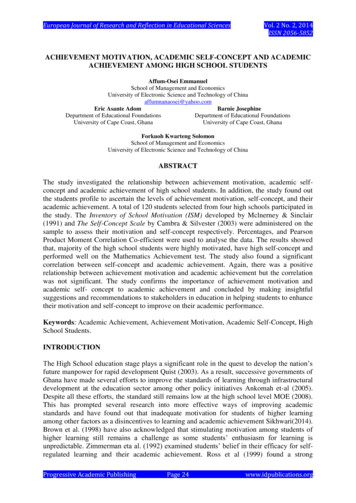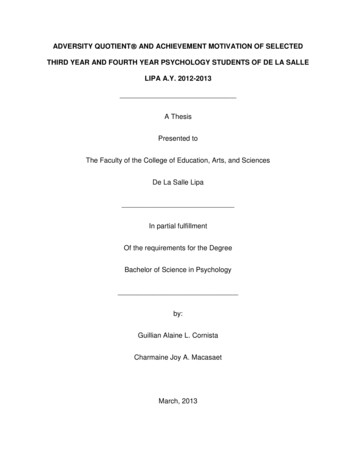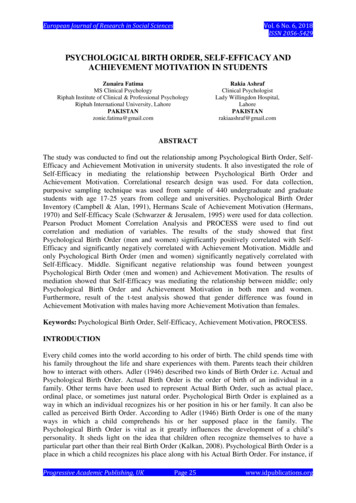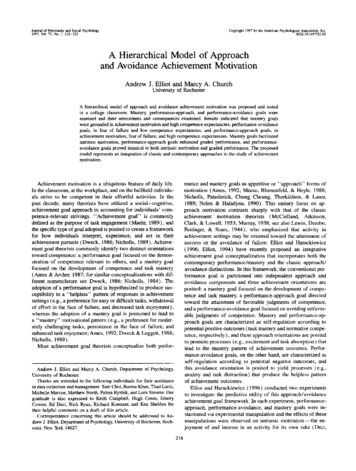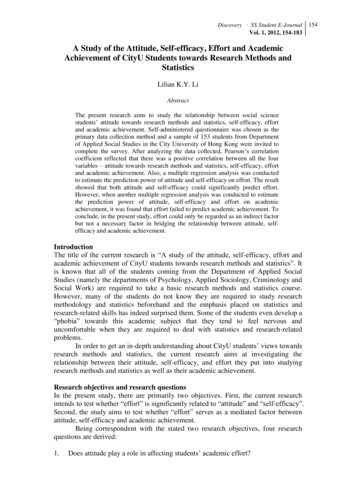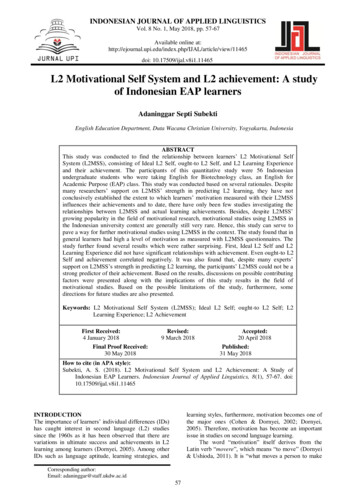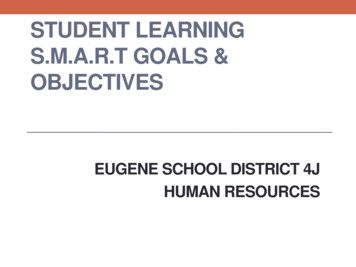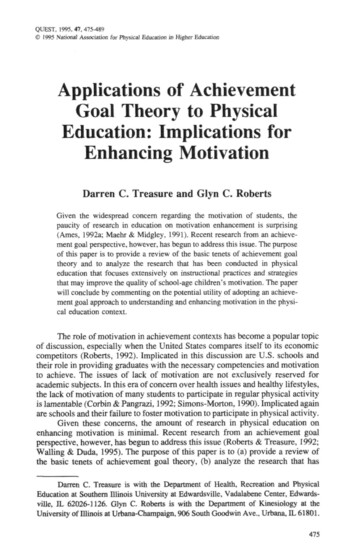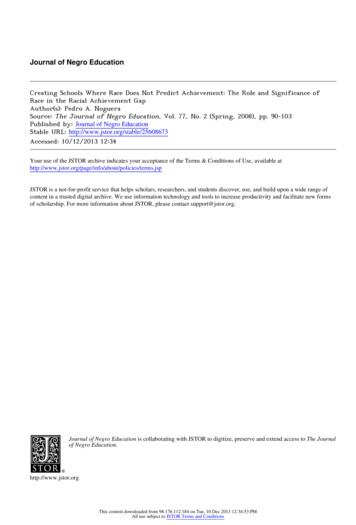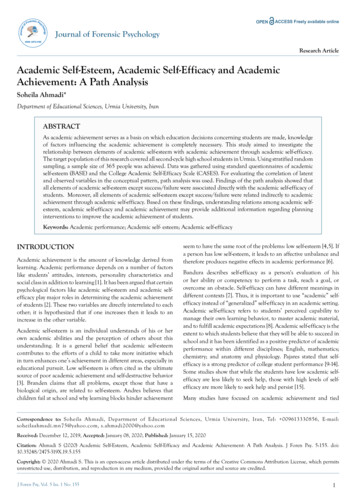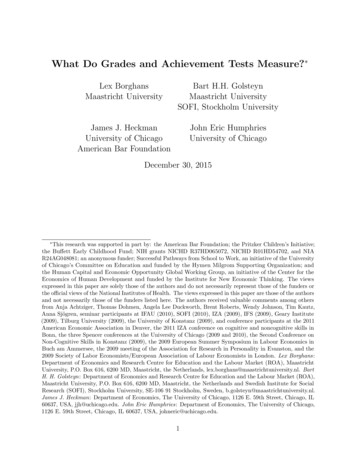
Transcription
What Do Grades and Achievement Tests Measure? Lex BorghansMaastricht UniversityBart H.H. GolsteynMaastricht UniversitySOFI, Stockholm UniversityJames J. HeckmanUniversity of ChicagoAmerican Bar FoundationJohn Eric HumphriesUniversity of ChicagoDecember 30, 2015 This research was supported in part by: the American Bar Foundation; the Pritzker Children’s Initiative;the Buffett Early Childhood Fund; NIH grants NICHD R37HD065072, NICHD R01HD54702, and NIAR24AG048081; an anonymous funder; Successful Pathways from School to Work, an initiative of the Universityof Chicago’s Committee on Education and funded by the Hymen Milgrom Supporting Organization; andthe Human Capital and Economic Opportunity Global Working Group, an initiative of the Center for theEconomics of Human Development and funded by the Institute for New Economic Thinking. The viewsexpressed in this paper are solely those of the authors and do not necessarily represent those of the funders orthe official views of the National Institutes of Health. The views expressed in this paper are those of the authorsand not necessarily those of the funders listed here. The authors received valuable comments among othersfrom Anja Achtziger, Thomas Dohmen, Angela Lee Duckworth, Brent Roberts, Wendy Johnson, Tim Kautz,Anna Sjögren, seminar participants at IFAU (2010), SOFI (2010), IZA (2009), IFS (2009), Geary Institute(2009), Tilburg University (2009), the University of Konstanz (2009), and conference participants at the 2011American Economic Association in Denver, the 2011 IZA conference on cognitive and noncognitive skills inBonn, the three Spencer conferences at the University of Chicago (2009 and 2010), the Second Conference onNon-Cognitive Skills in Konstanz (2009), the 2009 European Summer Symposium in Labour Economics inBuch am Ammersee, the 2009 meeting of the Association for Research in Personality in Evanston, and the2009 Society of Labor Economists/European Association of Labour Economists in London. Lex Borghans:Department of Economics and Research Centre for Education and the Labour Market (ROA), MaastrichtUniversity, P.O. Box 616, 6200 MD, Maastricht, the Netherlands, lex.borghans@maastrichtuniversity.nl. BartH. H. Golsteyn: Department of Economics and Research Centre for Education and the Labour Market (ROA),Maastricht University, P.O. Box 616, 6200 MD, Maastricht, the Netherlands and Swedish Institute for SocialResearch (SOFI), Stockholm University, SE-106 91 Stockholm, Sweden, b.golsteyn@maastrichtuniversity.nl.James J. Heckman: Department of Economics, The University of Chicago, 1126 E. 59th Street, Chicago, IL60637, USA, jjh@uchicago.edu. John Eric Humphries: Department of Economics, The University of Chicago,1126 E. 59th Street, Chicago, IL 60637, USA, johneric@uchicago.edu.1
What Do Grades and Achievement Tests Measure?December 30, 2015AbstractGrades and achievement tests are widely used as measures of cognition. This papershows that they are stronger predictors of many important life outcomes than IQ. Weexamine a variety of sources of evidence on what these measures capture and find thatpersonality contributes substantially to the predictive performance of these measures.This result has important implications for the interpretation of studies using cognitionto explain differences in outcomes and for the use of cognitive measures to evaluate theeffectiveness of public policies.Keywords: : IQ, Achievement tests, personality traitsJEL codes: J24, D032
What Do Grades and Achievement Tests Measure?December 30, 2015Contents1 Introduction42 A brief overview of the literature53 Data74 Decomposing grades and the scores on achievement tests into their constituent parts95 Decomposing the contributions of IQ and personality to life outcomes116 Conclusions and implications for policy133
What Do Grades and Achievement Tests Measure?1December 30, 2015IntroductionEconomists and psychologists have established that measures of “intelligence” or “cognition”predict success in a variety of domains of life (see, e.g., 29, 19, 31 and 32). A close lookat this evidence shows that different measures of cognitive ability are used by differentanalysts—grades, IQ, and scores on achievement tests (see the review in 5 and 2). Thesealternative measures are positively correlated and are often used interchangeably in analyzing“intelligence” (see 31 and 32).This paper examines these alternative measures and their constituent parts. Whatconcepts do these measures capture? What do they miss? Why is it important to distinguishamong these concepts? We establish that, on average, grades and achievement tests aregenerally better predictors of life outcomes than “pure” measures of IQ. This is becausethey capture aspects of personality that have been shown to be predictive in their own right.All of the standard measures of “intelligence” or “cognition” are influenced by aspects ofpersonality, albeit to varying degrees, depending on the measure.Achievement tests were designed to capture “general knowledge” acquired at school andin life (see, e.g., 20, 21). IQ tests were designed to capture “innate aptitudes” rather thanacquired knowledge (see 18). The distinction between IQ and achievement tests rests on thecrucial notion that aptitudes are fixed while knowledge is not. Yet a large body of scholarlyresearch shows that measures of IQ or aptitude can be altered through interventions (see, e.g.,the evidence in 2 and 15). Put differently, all measures of ability require some knowledge inorder to gauge the ability which is measured by performance on some task (e.g., taking a test).Knowledge can be acquired. At the same time, greater aptitude facilitates the acquisition ofknowledge. Empirically distinguishing knowledge from aptitude is a difficult problem.All measures of cognition are based on some aspects of acquired knowledge. Aspects ofpersonality affect the acquisition of knowledge (e.g., more motivated persons learn more).At the same time, they directly affect the performance on alternative gauges of cognitionfor persons with the same basic knowledge (e.g., more conscientious persons take tests more4
What Do Grades and Achievement Tests Measure?December 30, 2015seriously). See Borghans et al. [8].This paper establishes the following points: (1) Grades, achievement tests and IQ tests allpredict life outcomes. The three types of measures are all positively correlated, often stronglyso. Higher levels of these measures predict greater success on a number of economic andsocial dimensions. (2) The predictive power of these measures is ordered for most outcomes:achievement tests and grades are better predictors of most outcomes than are scores on IQtests. Their greater predictive power is a consequence of the fact that grades and achievementtests capture aspects of personality that have been shown to have independent predictivepower of a variety of social and economic outcomes. (3) Personality affects these measuresthrough two channels: (a) by promoting the acquisition of the knowledge that is the basis forthe measures and (b) by affecting the performance of persons with the same knowledge onthe gauges used to craft the measures.The paper proceeds as follows. Section 2 gives a brief overview of the literature. Section 3describes the data. Section 4 decomposes grades and scores on achievement tests into IQand personality. Section 5 analyzes to what extent other outcomes are predicted by IQ andpersonality. Section 6 concludes.2A brief overview of the literatureIn economics, achievement tests such as the Armed Forces Qualification Test (AFQT) areoften used as proxies for cognitive ability (See, e.g., 29, 30, and 19). Reviewing the literature,we document 50 papers which use the AFQT as a proxy for intelligence.1 Many other paperslook at other achievement tests or grades as proxies for IQ (see 22, 16, 31 and 32).The determinants of scores on achievement tests have not been studied in economics. In1The web appendix gives a (non-comprehensive) overview of papers, which use the AFQT as a proxy forintelligence.5
What Do Grades and Achievement Tests Measure?December 30, 2015psychology, articles have been written about the relationship between (1) IQ and Personality,2(2) academic achievement measured by school grades and IQ,3 and (3) academic achievementmeasured by school grades and personality.4,5 However, surprisingly little evidence has beengathered on the extent to which scores on achievement tests are determined by IQ relative topersonality.There are a few exceptions.6 For example, Duckworth et al. [13] report that self-control (afacet of Big 5 Conscientiousness) and IQ (measured by Raven Matrices) predict scores on theEnglish/Language Arts and Mathematics standardized achievement tests.7 An early paperby Barton et al. [3] relates the High School Personality Questionnaire and the Culture FairIntelligence Test to scores on standardized achievement tests. They find that conscientiousnessand IQ predict achievement. Duckworth and Carlson [10] provide an overview of the roleof self-regulation on school success. In their paper they discuss studies showing how selfregulation is related to standardized achievement tests, course grades, and high schoolachievement. The paper documents that self-regulation is more predictive of course gradesthan standardized achievement tests, and suggests this may be why course grades are morepredictive of some later-life outcomes than achievement tests.2Duckworth et al. [12] give an overview of this literature. In economics, scores on IQ tests have beenrelated to personality [6]. Segal [37] shows that low conscientious men perform better when they are offeredincentives in IQ tests and Borghans et al. [8] show that conscientious and emotionally stable people do notspend more time answering IQ questions when rewards are higher, while people who score lower on thesetraits do spend more time.3Ackerman and Heggestad [1] review the literature.4Poropat [34] and Poropat [35] give an overview of this literature. Poropat [34] concludes that conscientiousness is the largest big five predictor of grades (followed at some distance by openness to experience).Conscientiousness predicts grades almost equally well as intelligence. Poropat [35] evaluates how adolescentmeasures of the Big 5 predict academic performance – finding that openness and conscientiousness wereparticularly important. Noftle and Robins [33] investigate the relationship between verbal and mathematicSAT scores and the Big 5. They find that openness to experiences relates to SAT verbal scores.5It is beyond the scope of this paper to review the vast literature in psychology on these relationships.Almlund et al. [2] give a comprehensive overview.6Almlund et al. [2] and Duckworth and Carlson [10] discuss this literature.7Duckworth and Seligman [14] find for a small sample of students that both self-discipline and IQ (theOtis-Lennon School Ability Test Seventh edition) predict performance on the Terranova Second EditionAchievement Test Normal Curve Equivalent. This study reports correlations of the achievement test and IQand of the achievement test and self-discipline.6
What Do Grades and Achievement Tests Measure?3December 30, 2015DataFor our analyses we need data about IQ and personality at a young age, an achievement testat a young age and information about later life outcomes. No data set provides high qualityinformation on all these aspects. We therefore use four data sets. The first data set is from aDutch high school (Stella Maris). The second is the 1970 British Cohort Study. The third isthe U.S. National Longitudinal Study of Youth 1979 (NLSY79). The fourth data set is theNational Survey of Midlife Development in the United States (MIDUS).Data from the Stella Maris High School contain detailed information about achievement,IQ, and personality. They provide information on an achievement test (the DifferentialAptitude Test, DAT), a test of cognitive ability (Raven Progressive Matrices), variousmeasures of personality (Big 5, Grit) and measures of school performance (grades).8,9 RavenProgressive Matrices and the Big 5 are generally considered to be the best measures for fluidintelligence and the diversity in personality among people respectively [5].The British Cohort Study follows a cohort of children born in Britain during one weekin April 1970 until they are 38 years of age.10 The data contain information collected atage 10 on the children’s cognitive ability, some of their personality traits and data fromfour achievement tests. At age 16, scores on three other achievement tests are collected. In8The sample contains 347 Dutch students, 15 and 16 years of age. (See 6.)We use the following measures of personality: 50 items to measure the Big 5 (Openness (Cronbach’sAlpha 0.73), Conscientiousness (alpha 0.82), Extraversion (alpha 0.86), Agreeableness (alpha 0.79),Neuroticism (alpha 0.81)) from Goldberg [17] and 17 questions to measure Grit, a measure of perseveranceand passion for long term goals (alpha 0.700), from Duckworth et al. [11]. We use the principal componentof 8 Raven Progressive Matrices as a measure of IQ (alpha 0.62). The Raven matrices are often consideredto have the highest loading on g (23). See Jensen [25]. For dissenting views, see Mackintosh and Bennett [27]and Maltby et al. [28]. From administrative records, we obtain scores on the Dutch Differential Aptitude Test(DAT) comparable to the American DAT, an achievement test taken at age 15. The DAT and the AFQT aresimilar in terms of components and the DAT and AFQT correlate highly (0.75). Therefore, conclusions wedraw based on the DAT will be instructive about the AFQT as well. [JJH: We need a reference for this— it’s in the GED book]10The sample included 17,198 babies in April 1970.97
What Do Grades and Achievement Tests Measure?December 30, 2015addition, these data include many life outcomes.11 The personality measures are not thestandard measures that are used nowadays but cover a richer variety than the NLSY.The NLSY79 contains Armed Forces Qualifying Test (AFQT) scores, scores on IQ tests,12two measures of personality—the Rotter measure of locus of control and Rosenberg measureof self-esteem, grades in high school and many outcomes later in life. The informationon personality with only two measures is quite limited, and the IQ information had to begathered by combining different IQ-tests, that would nowadays not be considered to be theoptimal tests for these purposes.The National Survey of Midlife Development in the United States (MIDUS) is administeredin two rounds of interviews. The first was conducted in 1995 and 1996 when respondents were24-74 years old, and the second was conducted between 2004 and 2006, when respondents were34-83. MIDUS aimed to be an “interdisciplinary investigation of patterns, predictors, andconsequences of midlife development in the areas of physical health, psychological well-being,and social responsibility. The data collection is comprised of four parts.13 ” The data containpsychological measures, background, economic, health, and behavioral data. The surveyincludes 7,108 respondents (some belonging to a siblings and twins sub-datasets). The survey11Cognitive ability is measured by the Matrices subtest of the British Ability Scales, which is a test similarto the Raven Progressive Matrices test. It contains 28 items. Personality traits include measures of self-esteem(16 items, alpha 0.69) and locus of control (16 items, alpha 0.63) (both based on questions answered by therespondents) and measures of disorganized activity (11 items, alpha 0.93), anti-social behavior (10 items,alpha 0.92), neuroticism (5 items, alpha 0.85) and introversion (5 items, alpha 0.58) (based on questionsanswered by the pupils’ teachers). The achievement tests at age 10 include: 1. the British Ability Scaleswhich include two verbal subscales (Word definitions and Similarities) and two non-verbal subscales (Recallof Digits and Matrices), 2. The Friendly Math Test, 3. The Edinburgh Reading Test and 4. The ChessPictorial Language Comprehension Test. At age 16, scores on three other achievement tests are collected: 1.A vocabulary test, 2. A spelling test, and 3. The scores on a Math test. Next to this, the data include manylife outcomes. We use: 1. Wages (at age 38), 2. Age when left education (asked at age 34), 3. The BodyMass Index (age 34), 4. Number of times been arrested and taken to a policy station (age 34), 5. Satisfactionwith life so far (age 34).12The NLSY includes many IQ tests collected from school transcript data for subgroups (the numberof respondents is reported in parentheses): California Test of Mental Maturity (599), Lorge-ThorndikeIntelligence Test (691), Henmon-Nelson Test of Mental Maturity (201), Kuhlmann-Anderson Intelligence Test(176), Stanford-Binet Intelligence Scale (101), and Wechsler Intelligence Scale for Children (120). The date atwhich these tests are administered ranges from early childhood to the 12th grade. We use IQ percentile. Theadvantage of percentile scores is that—in theory—they should be comparable across tests, allowing us topool test scores from the IQ tests for a much larger sample of test php8
What Do Grades and Achievement Tests Measure?December 30, 2015consisted of a telephone survey and mail-based questionnaire. Excluding the oversamples oftwins and siblings and excluding respondents who were not interviewed in the second round,the main sample of individuals interviewed in both waves consists of 3,487 individuals. Thesecond round of interviews provides follow-up data of these 3,487 individuals 7 to 11 yearslater.14 The analysis in this paper focuses on those 60 and younger during MIDUS II whowere part of the main sample. While MIDUS includes measures of personality, cognitiveability, and outcomes, it does not provide an achievement test.In summary, the NLSY includes the AFQT as an achievement test, which is commonlyused in the literature, and is a prospective survey of many life outcomes, but is limitedin the quality of both the IQ-measure and measures of personality. The Stella Maris datahas a rich set of IQ and personality measures, but only measures short term outcomes ofparticipants in school. BCS has rich IQ measures and long run outcomes of participants, withpersonality measures that are richer than those in the NLSY but are limited relative to whatis available in Stella Maris. Finally, MIDUS provides measures of the Big 5 personality traits,(something absent from almost every other survey with economic outcomes administered inthe United States), a measure of cognitive ability, and a number of outcomes. However, itinitially interviews participants at later stages of the life cycle.4Decomposing grades and the scores on achievementtests into their constituent partsFigure 1 shows the predictive power of personality and IQ on grades and scores on achievementtests. The results from the Stella Maris data in Panel A indicate that scores on the Raven’s14Big 5 personality traits were measured by 30 questions on how well the respondent is described bydescriptive adjectives. See Rossi [36] for details. The scale measures the Big 5 personality traits: neuroticism(alpha 0.74), extraversion (alpha 0.78), openness (alpha 0.77), conscientiousness (alpha 0.58),and agreeableness (alpha 0.80). Cognitive ability is measured by the Brief Test of Adult Cognition byTelephone (BTACT). The BTACT is the only measure of cognition in MIDUS. The test includes word listrecall, delayed word list recall, counting digits backwards, categorical fluency, and number series. While not aformal IQ test, many of the sub-tests are included in some IQ tests. See Tun and Lachman [38] for details.9
What Do Grades and Achievement Tests Measure?December 30, 2015Progressive Matrices test explain more of the variance in DAT scores than do personalitymeasures. However, personality variables also explain a substantial fraction of the variancein the DAT for both men and women and continue to have predictive power when Ravenis included in the same regression. In the Stella Maris data, grades are mostly relatedto personality traits. The correlations differ for women and men. Grit is an importantdeterminant of GPA for women, while for men, Conscientiousness and Emotional Stabilityare important. Scores on the Raven test do not predict overall grades for men or women.R-squares increase substantially when personality is added to the regressions. This increaseindicates that a much larger part of the variation in GPA is explained by personality than byRaven.Panel B of Figure 1 decomposes achievement tests using data from the British CohortStudy. The results show that IQ and personality measured at age 10 predict scores on variousachievement tests both at age 10 and age 16.The NLSY data in Panel C show that IQ explains more of the variance in AFQT scoresthan do Rosenberg and Rotter, but both personality measures are predictive. Decomposingninth grade grade point average, we find that IQ explains more of the variance in grades thanRosenberg and Rotter, but these personality measures still provide explanatory power aboveand beyond IQ. However, both personality and IQ measures leave much unaccounted for. Itis important to note that our particular measures of personality traits (locus of control andself-esteem) are only a subset of the wide array of personality traits used by psychologists.15Unlike the NLSY79, MIDUS contains measures of Big-5 personality traits, yet it doesnot contain an achievement test of the quality of AFQT. We rely on MIDUS only fordemonstrating the correlations between cognition, personality, and outcomes.In sum, achievement tests and grades are positively correlated with both IQ and personality.Additionally, personality explains part of achievement test scores beyond that explained byIQ alone.15See Almlund et al. [2] for a summary of these measures.10
What Do Grades and Achievement Tests Measure?5December 30, 2015Decomposing the contributions of IQ and personalityto life outcomesUsing the BCS, NLSY, and MIDUS, we conduct analyses to determine how much of thevariation in several important life outcomes is explained by IQ and personality traits. Webuild on the analyses of Borghans et al. [7], Almlund et al. [2], Heckman and Kautz [20] andHeckman and Kautz [21]. The array of outcomes includes schooling, health, earnings, andemployment.The BCS data in Figure 2 reveal that for wages, years of schooling, the Body Mass Index,number of arrests and life satisfaction, personality explains at least an equal amount of thevariation in life outcomes than does IQ. Notice however that the variation which IQ andpersonality explain remains low. As a specimen of this array of outcomes, Table 1 showsthe wage regressions on IQ, personality traits and various achievement tests. Column 1shows that IQ predicts the wage. Column 2 shows that self-esteem, locus of control, andneuroticism are determinants of the wage. Both the correlations of IQ and the wage, and ofpersonality and the wage, remain significant when IQ and personality are included in theregression simultaneously (column 3).16 The fourth column shows that the BAS achievementtest has more predictive power than IQ and personality alone. When IQ and personality arealso included in the regression (column 5), the BAS achievement test remains an importantpredictor of the wage, and IQ and personality also remain significant predictors of the wage.In the other columns we run similar regressions using the other three achievement tests aspredictors instead of the BAS. We find that achievement remains an important and significantpredictor. After controlling for achievement tests, IQ is no longer statistically significant butpersonality remains a significant predictor of the wage.Using the NLSY79, Figure 3 parses the contributions of personality and IQ to a largerset of outcomes. The figure shows that IQ and personality only explain a small portion16The R-squareds of column 1, 2 and 3 are displayed in Figure 2.11
What Do Grades and Achievement Tests Measure?December 30, 2015of the variance in all of the outcomes studied, but that both are important predictors. IQexplains more of the variance for log-wages, any welfare, and physical health at age 40 whilepersonality explains more of the variance in mental health at age 40 and if the individualvoted in 2006.Table 2 shows the full set of regression results for log wages at age 40. The first columnincludes only IQ, the second column includes only personality, the third column includes IQand personality, the fourth column includes only AFQT scores. Columns five and six addback in IQ and personality, and column seven includes IQ, personality, and achievement testscores. Table 2 reveals that IQ and Rosenberg are statistically significant predictors of logwages at age 40 when AFQT is not added to the regression. AFQT is a significant predictor ofoutcomes, even after controlling for personality and IQ. Once AFQT is added, IQ has a smalland statistically insignificant coefficient while Rosenberg remains statistically significant. Itappears that the achievement test picks up other traits besides IQ and personality which arepositively correlated with life outcomes.17Finally, MIDUS allows us to consider the correlation of Big 5 personality traits witheconomic and health outcomes. Figure 4 demonstrates that the Big 5 personality measures inthe MIDUS data explain a much larger percent of the variance than the measure of cognitionfor both wage and health outcomes. Table 3 shows the coefficients on cognitive ability andthe Big 5 personality traits for log wages. We see that cognition is important, but that alarger portion of the variance is explained by personality. Conscientiousness and Opennessare positively related to log wages while agreeableness is negatively related. Controllingfor personality lowers the coefficient on cognition by almost a third. Results form MIDUSsuggest that even more predictive power would be attributed to personality given bettermeasures in our other data sets.17Though both the measures of IQ and personality are limited in the NLSY79, it may be that theachievement test captures aspects of both of these constructs that our limited measures miss.12
What Do Grades and Achievement Tests Measure?6December 30, 2015Conclusions and implications for policyMeasured cognitive skills are important determinants of life outcomes. This paper reinterpretsthe evidence on the relationship between cognitive skills and social outcomes by analyzing thenature of widely used proxies for cognitive skills—grades and achievement tests. Measures ofpersonality predict achievement test scores and grades above and beyond IQ scores. Therefore,analyses using scores on achievement tests and grades as proxies for IQ conflate the effects ofIQ with the effects of personality. A main conclusion of our paper is that it is important notto interpret predictions of achievement tests and grades with outcomes as solely predictionsof IQ with outcomes.Why does any of this matter? If a test is used to measure the traits required for successin school or in life, then it is important to know what ingredients go into it and howthose ingredients are determined to devise wise social policies to promote success. Socialpolicy should recognize and measure the multiple predictors of success. Understanding whatconstitutes the tests scores and grades used to explain the Black-White achievement gap [24],the male-female wage gap (see, e.g., 4, and 9), and the PISA score and No Child Left Behindtest score gaps by social class directs attention to what factors give rise to the gaps and howthey might be remediated (see 21).It is common to measure the performance of children in school by achievement tests.Although achievement tests indirectly measure personality traits as an amalgam, our analysisindicates that personality and cognitive traits should be separated more clearly and controlledfor in order to understand test score gaps. For example, the No Child Left Behind Actfocuses on improving achievement test scores in math and reading for the lowest part of thedistribution. The focus of No Child Left Behind is on improving performance on cognitivetasks. Our analysis shows that personality matters in life, so NCLB’s focus likely misdirectsattention from personality and other important aspects of education (see, e.g., 26 and 21).Such a focus misleads social policy by focusing on one dimension of performance when manydimensions matter. This affects the design of policies to improve the curriculum.13
What Do Grades and Achievement Tests Measure?December 30, 2015When Herrnstein and Murray [22] measure the predictive performance of IQ—as measuredby AFQT tests—and go on to address the heritable nature of IQ and the difficulty of boostingit using social policy, they confuse many issues. AFQT scores are strongly shaped bypersonality. Personality traits are malleable (see 21). The dystopic vision of inequality inAmerica by Herrnstein and Murray is reversed by a better understanding of what AQFTactually measures and how its sources can be shaped by social policy.14
What Do Grades and Achievement Tests Measure?December 30, 2015Figure 1: Decomposing Achievement Tests and Grades into IQ and Personality(A) Stella Maris0.250.20R-squared0.150.100.050.00Achievement (DAT)GradesIQBig 5 and GritIQ, Big 5 and GritNotes: The Stella Maris data include 347 Dutch high school students aged 15 or 16 in 2008. The Big 5(Openness, Conscientiousness, Extraversion, Agreeableness, Neuroticism) from Goldberg [17] is measuredwith 10 items per trait. Grit, a measure of perseverance and passion for long-term goals, from Duckworthet al. [11] is measured with 17 questions. IQ is the principal component of 8 Raven Progressive Matrices
What Do Grades and Achievement Tests Measure? December 30, 2015 psychology, articles have been written about the relationship between (1) IQ and Personality,2 (2) academic achievement measured by school grades and IQ,3 and (3) academic achievement measured by school grades and personality.4;5 However, surprisingly little evidence has been gathered on the extent to which scores on achievement .
